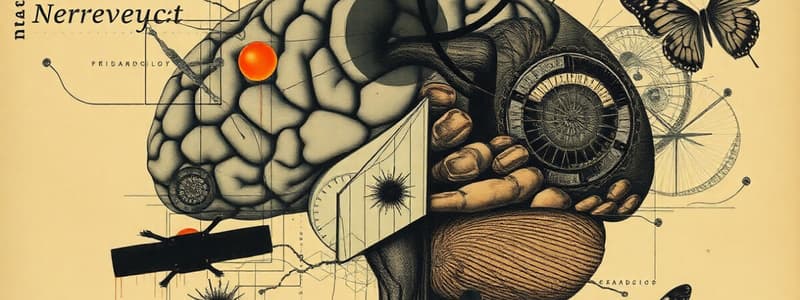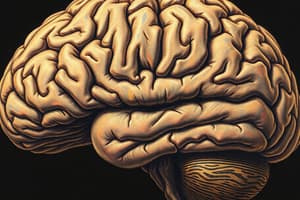Podcast
Questions and Answers
Which of the following is NOT a component of the central nervous system (CNS)?
Which of the following is NOT a component of the central nervous system (CNS)?
- Spinal cord
- Cranial nerves (correct)
- Brain
- Peripheral nerves
What is the name of the ectodermal structure that forms the nervous system?
What is the name of the ectodermal structure that forms the nervous system?
Neural plate
The process of neural tube formation is called neurulation.
The process of neural tube formation is called neurulation.
True (A)
What structure is formed by the folding of the neural plate?
What structure is formed by the folding of the neural plate?
Which of the following is a key function of the cells derived from the neural crest?
Which of the following is a key function of the cells derived from the neural crest?
Rostral refers to the direction towards the tail or back.
Rostral refers to the direction towards the tail or back.
The ________ matter of the brain contains neuron cell bodies and dendrites.
The ________ matter of the brain contains neuron cell bodies and dendrites.
What is the primary component of white matter?
What is the primary component of white matter?
What is the condition called when the neural tube fails to close at the caudal end?
What is the condition called when the neural tube fails to close at the caudal end?
Anencephaly is a condition that occurs when the rostral end of the neural tube fails to close.
Anencephaly is a condition that occurs when the rostral end of the neural tube fails to close.
What is the name of the fluid that circulates in the brain's ventricular system?
What is the name of the fluid that circulates in the brain's ventricular system?
Which of these is a function of the dural sinuses?
Which of these is a function of the dural sinuses?
The presence of a blood-brain barrier provides protection for the brain by regulating the movement of substances into the brain tissue.
The presence of a blood-brain barrier provides protection for the brain by regulating the movement of substances into the brain tissue.
What is the largest brain division responsible for higher cognitive functions?
What is the largest brain division responsible for higher cognitive functions?
What is the outermost layer of the cerebrum called?
What is the outermost layer of the cerebrum called?
What part of the brain serves as a relay center for sensory information?
What part of the brain serves as a relay center for sensory information?
Which part of the brain regulates autonomic functions and homeostasis?
Which part of the brain regulates autonomic functions and homeostasis?
What type of glial cells support neurons in the central nervous system?
What type of glial cells support neurons in the central nervous system?
Oligodendrocytes are glial cells that myelinate axons in the peripheral nervous system.
Oligodendrocytes are glial cells that myelinate axons in the peripheral nervous system.
Which of the following glial cells line the ventricles and produce cerebrospinal fluid?
Which of the following glial cells line the ventricles and produce cerebrospinal fluid?
The choroid plexus is responsible for the production of cerebrospinal fluid (CSF).
The choroid plexus is responsible for the production of cerebrospinal fluid (CSF).
The process of the neural tube completely closing is called ________ .
The process of the neural tube completely closing is called ________ .
What are dorsal root ganglia?
What are dorsal root ganglia?
Schwann cells are responsible for the myelination of axons in the central nervous system.
Schwann cells are responsible for the myelination of axons in the central nervous system.
What is the role of satellite cells in the peripheral nervous system?
What is the role of satellite cells in the peripheral nervous system?
Which of these brain structures is primarily involved in regulating emotional responses and behaviors?
Which of these brain structures is primarily involved in regulating emotional responses and behaviors?
Circadian rhythms are biological processes that follow a 24-hour cycle.
Circadian rhythms are biological processes that follow a 24-hour cycle.
What gland produces melatonin, which helps regulate sleep cycles?
What gland produces melatonin, which helps regulate sleep cycles?
Which part of the brain coordinates smooth movements and balance?
Which part of the brain coordinates smooth movements and balance?
The cerebellum is connected to the brainstem divisions by structures called ________ .
The cerebellum is connected to the brainstem divisions by structures called ________ .
The dura mater forms the outer protective layer of the brain.
The dura mater forms the outer protective layer of the brain.
What is the primary function of the blood-brain barrier?
What is the primary function of the blood-brain barrier?
The ventricular system consists of interconnected cavities in the brain that contain cerebrospinal fluid.
The ventricular system consists of interconnected cavities in the brain that contain cerebrospinal fluid.
What is hydrocephalus?
What is hydrocephalus?
Which procedure is used to sample cerebrospinal fluid?
Which procedure is used to sample cerebrospinal fluid?
What is the name of the narrow channel that connects the third and fourth ventricles?
What is the name of the narrow channel that connects the third and fourth ventricles?
Where is the subarachnoid space located?
Where is the subarachnoid space located?
Arachnoid granulations allow for the absorption of cerebrospinal fluid into the blood.
Arachnoid granulations allow for the absorption of cerebrospinal fluid into the blood.
What brain region contains respiratory centers that control breathing patterns?
What brain region contains respiratory centers that control breathing patterns?
Which of the following is NOT a function regulated by the Cardiovascular Center in the brainstem?
Which of the following is NOT a function regulated by the Cardiovascular Center in the brainstem?
The Digestive Center in the brainstem coordinates digestive activities with other body functions.
The Digestive Center in the brainstem coordinates digestive activities with other body functions.
There are ________ pairs of cranial nerves.
There are ________ pairs of cranial nerves.
What type of information is carried by descending tracts?
What type of information is carried by descending tracts?
What kind of information do ascending tracts carry?
What kind of information do ascending tracts carry?
The ________ is a dural partition that separates the cerebral hemispheres.
The ________ is a dural partition that separates the cerebral hemispheres.
The tentorium cerebelli is a dural partition between the cerebellum and the cerebrum.
The tentorium cerebelli is a dural partition between the cerebellum and the cerebrum.
Flashcards
Central Nervous System (CNS)
Central Nervous System (CNS)
The brain and spinal cord.
Peripheral Nervous System (PNS)
Peripheral Nervous System (PNS)
Nerves outside the brain and spinal cord.
Neural Plate
Neural Plate
Ectoderm structure forming the nervous system.
Neural Tube
Neural Tube
Signup and view all the flashcards
Neural Crest
Neural Crest
Signup and view all the flashcards
Neurulation
Neurulation
Signup and view all the flashcards
Rostral
Rostral
Signup and view all the flashcards
Caudal
Caudal
Signup and view all the flashcards
Gray Matter
Gray Matter
Signup and view all the flashcards
White Matter
White Matter
Signup and view all the flashcards
Spina Bifida
Spina Bifida
Signup and view all the flashcards
Anencephaly
Anencephaly
Signup and view all the flashcards
Cerebrospinal Fluid (CSF)
Cerebrospinal Fluid (CSF)
Signup and view all the flashcards
Blood-Brain Barrier
Blood-Brain Barrier
Signup and view all the flashcards
Cerebrum
Cerebrum
Signup and view all the flashcards
Cerebral Cortex
Cerebral Cortex
Signup and view all the flashcards
Thalamus
Thalamus
Signup and view all the flashcards
Hypothalamus
Hypothalamus
Signup and view all the flashcards
Astrocytes
Astrocytes
Signup and view all the flashcards
Cerebellum
Cerebellum
Signup and view all the flashcards
Study Notes
Central Nervous System (CNS)
- CNS includes the brain and spinal cord.
Peripheral Nervous System (PNS)
- PNS comprises nerves outside the brain and spinal cord.
Neural Plate
- Ectodermal structure that develops into the nervous system.
Neural Tube
- Formed by the folding of the neural plate.
Neural Crest
- Cells forming parts of the PNS and other structures.
Neurulation
- The process of neural tube formation.
Rostral
- Direction towards the head or front.
Caudal
- Direction towards the tail or back.
Gray Matter
- Composed of neuron cell bodies and dendrites.
White Matter
- Made up of myelinated axons.
Spina Bifida
- Neural tube defect at the caudal end.
Anencephaly
- Fatal neural tube defect arising from failure of rostral closure.
Cerebrospinal Fluid (CSF)
- Fluid circulating in brain ventricles.
Dural Sinuses
- Venous channels between dural layers.
Blood-Brain Barrier
- Controls what enters the brain.
Cerebrum
- Largest brain division with higher functions.
Cerebral Cortex
- Outer layer of the cerebrum.
Thalamus
- Relay center for sensory information.
Hypothalamus
- Regulates homeostasis and autonomic functions.
Astrocytes
- Supporting glial cells in the CNS.
Oligodendrocytes
- Myelinate axons in the CNS.
Ependymal Cells
- Line ventricles and produce CSF.
Choroid Plexus
- Structures that produce CSF.
Neural Tube Closure
- Completion of neural tube formation.
Dorsal Root Ganglia
- Clusters of sensory neurons in the PNS.
Schwann Cells
- Myelinate axons in the PNS.
Satellite Cells
- Support neurons in PNS ganglia.
Limbic System
- Regulates emotions and behaviors.
Circadian Rhythms
- Biological processes with a 24-hour cycle.
Pineal Gland
- Produces melatonin influencing sleep.
Cerebellum
- Coordinates movements.
Cerebellar Peduncles
- Connect cerebellum to the brainstem.
Dura Mater
- Outer protective layer of the brain.
Ventricular System
- Cavities filled with CSF in the brain.
Hydrocephalus
- Increased CSF, causing brain pressure.
Spinal Tap
- Procedure to obtain CSF.
Cerebral Aqueduct
- Channel connecting third and fourth ventricles.
Subarachnoid Space
- Space containing CSF below the arachnoid membrane.
Arachnoid Granulations
- Structures absorbing CSF into blood.
Respiratory Centers
- Control respiratory processes in the brainstem.
Cardiovascular Center
- Regulates heart and blood pressure.
Digestive Center
- Coordinates digestive activities.
Cranial Nerves
- 12 pairs attaching to the brainstem.
Descending Tracts
- Carry motor information to the body.
Ascending Tracts
- Carry sensory information to the brain.
Falx Cerebri
- Dural partition separating the cerebral hemispheres.
Tentorium Cerebelli
- Dural partition between the cerebellum and cerebrum.
Studying That Suits You
Use AI to generate personalized quizzes and flashcards to suit your learning preferences.
Description
Test your knowledge on the central and peripheral nervous systems with this quiz. Delve into the processes of neurulation and the intricate structures such as the neural tube and neural crest. Explore various nervous system defects and components, including gray matter and cerebrospinal fluid.




